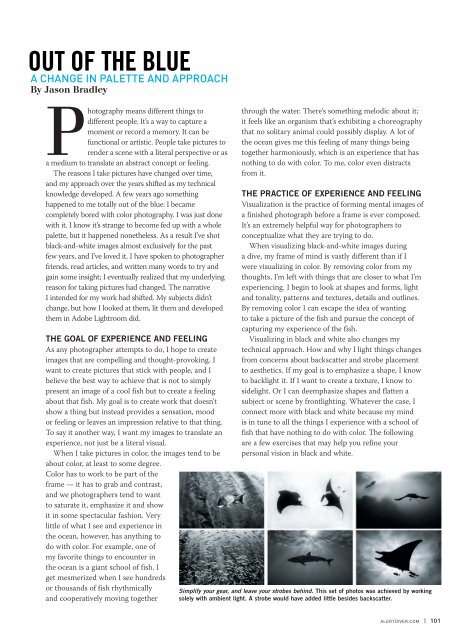AD 2016 Q4
Alert Diver is the dive industry’s leading publication. Featuring DAN’s core content of dive safety, research, education and medical information, each issue is a must-read reference, archived and shared by passionate scuba enthusiasts. In addition, Alert Diver showcases fascinating dive destinations and marine environmental topics through images from the world’s greatest underwater photographers and stories from the most experienced and eloquent dive journalists in the business.
Alert Diver is the dive industry’s leading publication. Featuring DAN’s core content of dive safety, research, education and medical information, each issue is a must-read reference, archived and shared by passionate scuba enthusiasts. In addition, Alert Diver showcases fascinating dive destinations and marine environmental topics through images from the world’s greatest underwater photographers and stories from the most experienced and eloquent dive journalists in the business.
You also want an ePaper? Increase the reach of your titles
YUMPU automatically turns print PDFs into web optimized ePapers that Google loves.
OUT OF THE BLUE<br />
A CHANGE IN PALETTE AND APPROACH<br />
By Jason Bradley<br />
Photography means different things to<br />
different people. It’s a way to capture a<br />
moment or record a memory. It can be<br />
functional or artistic. People take pictures to<br />
render a scene with a literal perspective or as<br />
a medium to translate an abstract concept or feeling.<br />
The reasons I take pictures have changed over time,<br />
and my approach over the years shifted as my technical<br />
knowledge developed. A few years ago something<br />
happened to me totally out of the blue: I became<br />
completely bored with color photography. I was just done<br />
with it. I know it’s strange to become fed up with a whole<br />
palette, but it happened nonetheless. As a result I’ve shot<br />
black-and-white images almost exclusively for the past<br />
few years, and I’ve loved it. I have spoken to photographer<br />
friends, read articles, and written many words to try and<br />
gain some insight; I eventually realized that my underlying<br />
reason for taking pictures had changed. The narrative<br />
I intended for my work had shifted. My subjects didn’t<br />
change, but how I looked at them, lit them and developed<br />
them in Adobe Lightroom did.<br />
THE GOAL OF EXPERIENCE AND FEELING<br />
As any photographer attempts to do, I hope to create<br />
images that are compelling and thought-provoking. I<br />
want to create pictures that stick with people, and I<br />
believe the best way to achieve that is not to simply<br />
present an image of a cool fish but to create a feeling<br />
about that fish. My goal is to create work that doesn’t<br />
show a thing but instead provides a sensation, mood<br />
or feeling or leaves an impression relative to that thing.<br />
To say it another way, I want my images to translate an<br />
experience, not just be a literal visual.<br />
When I take pictures in color, the images tend to be<br />
about color, at least to some degree.<br />
Color has to work to be part of the<br />
frame — it has to grab and contrast,<br />
and we photographers tend to want<br />
to saturate it, emphasize it and show<br />
it in some spectacular fashion. Very<br />
little of what I see and experience in<br />
the ocean, however, has anything to<br />
do with color. For example, one of<br />
my favorite things to encounter in<br />
the ocean is a giant school of fish. I<br />
get mesmerized when I see hundreds<br />
or thousands of fish rhythmically<br />
and cooperatively moving together<br />
through the water. There’s something melodic about it;<br />
it feels like an organism that’s exhibiting a choreography<br />
that no solitary animal could possibly display. A lot of<br />
the ocean gives me this feeling of many things being<br />
together harmoniously, which is an experience that has<br />
nothing to do with color. To me, color even distracts<br />
from it.<br />
THE PRACTICE OF EXPERIENCE AND FEELING<br />
Visualization is the practice of forming mental images of<br />
a finished photograph before a frame is ever composed.<br />
It’s an extremely helpful way for photographers to<br />
conceptualize what they are trying to do.<br />
When visualizing black-and-white images during<br />
a dive, my frame of mind is vastly different than if I<br />
were visualizing in color. By removing color from my<br />
thoughts, I’m left with things that are closer to what I’m<br />
experiencing. I begin to look at shapes and forms, light<br />
and tonality, patterns and textures, details and outlines.<br />
By removing color I can escape the idea of wanting<br />
to take a picture of the fish and pursue the concept of<br />
capturing my experience of the fish.<br />
Visualizing in black and white also changes my<br />
technical approach. How and why I light things changes<br />
from concerns about backscatter and strobe placement<br />
to aesthetics. If my goal is to emphasize a shape, I know<br />
to backlight it. If I want to create a texture, I know to<br />
sidelight. Or I can deemphasize shapes and flatten a<br />
subject or scene by frontlighting. Whatever the case, I<br />
connect more with black and white because my mind<br />
is in tune to all the things I experience with a school of<br />
fish that have nothing to do with color. The following<br />
are a few exercises that may help you refine your<br />
personal vision in black and white.<br />
Simplify your gear, and leave your strobes behind. This set of photos was achieved by working<br />
solely with ambient light. A strobe would have added little besides backscatter.<br />
ALERTDIVER.COM | 101










